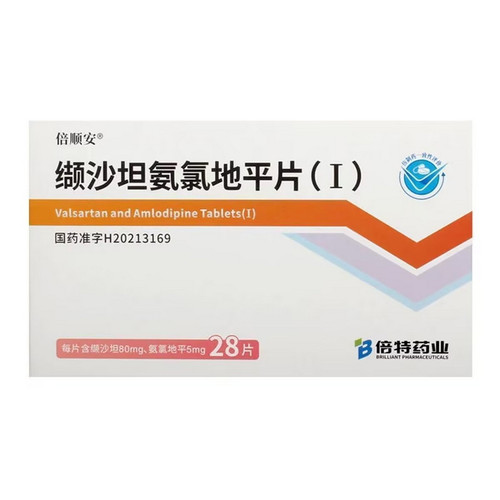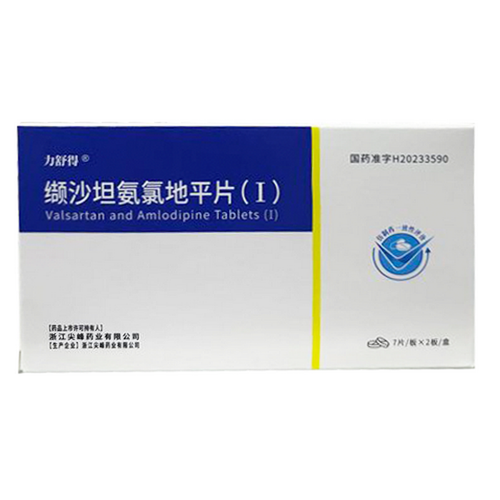Product Overview
[Drug Name]
Generic Name: Pinsartan Amlodipine Tablets (I)
Trade Name: Yiluoping ZuoShaTanAnLvDiPingPian (I) 15 Tablets
Pinyin Code: YiLuoPing ZuoShaTanAnLvDiPingPian (I) 15 Tablets
[Main Ingredients]
This product is a compound preparation containing 80mg of valsartan and 5mg of amlodipine per tablet.
[Properties]
This product is a film-coated tablet that appears white after removal of the coating.
[Indications/Main Functions]
Treatment of essential hypertension. This product is used for patients whose blood pressure cannot be adequately controlled with monotherapy.
[Specifications]
15 tablets
[Dosage and Administration]
Amlodipine 2.5mg to 10mg once daily is effective for the treatment of hypertension, while the effective dose of valsartan is 80mg to 320mg. In clinical trials of once-daily valsartan-amlodipine tablets, using doses of 5mg to 10mg of amlodipine and 80mg to 320mg of valsartan, the antihypertensive effect increased with increasing dose. Valsartan's adverse reactions are generally dose-independent; amlodipine's adverse reactions are both dose-dependent (primarily peripheral edema) and dose-independent, with the former being more common than the latter. This product can be used as an alternative for patients whose blood pressure is not adequately controlled with monotherapy. Add-on therapy: Patients whose blood pressure is not adequately controlled with amlodipine or valsartan monotherapy can be treated with this product in combination therapy. Patients who experience dose-limiting adverse reactions with amlodipine or valsartan monotherapy can be treated with this product, combining a lower dose of the individual component with the other component to achieve blood pressure control. The majority of the therapeutic effect is typically achieved within 2 weeks of initiating or changing the dose. Alternative Therapy: For ease of dosing, patients receiving amlodipine and pinsartan monotherapy can be switched to this product at the same dose. Both amlodipine and pinsartan can be taken with or without food. This product is recommended for administration with water. No dose adjustment is required for patients with mild or moderate renal impairment. Use with caution in patients with severe renal impairment (see [Contraindications]). This product should also be used with caution in patients with hepatic impairment or biliary obstructive disease (see [Precautions]).
[Adverse Reactions]
See the package insert for details.
[Contraindications]
This product is contraindicated in patients with hypersensitivity to the active ingredient or any of the excipients. It is contraindicated in pregnant and lactating women (see [Use in Pregnant and Lactating Women]). No data are currently available for use in patients with severe renal impairment (creatinine clearance <10 ml/min). This product should not be used in patients with hereditary angioedema or those who develop angioedema early in treatment with ACE inhibitors or angiotensin 1l receptor antagonists. Angiotensin receptor blockers (ARBs) (including sonsartan) or angiotensin-converting enzyme inhibitors (ACEIs) should not be used concomitantly with aliskiren in patients with type 2 diabetes (see [Drug Interactions]).
[Precautions]
Patients with Sodium and/or Volume Depletion: In placebo-controlled trials, 0.4% of patients with uncomplicated hypertension treated with valsartan and amlodipine tablets experienced excessive hypotension. Patients with an activated renin-angiotensin system (e.g., those with volume and/or salt depletion taking high-dose diuretics) may experience symptomatic hypotension when receiving angiotensin I receptor antagonists. Due to inhibition of the renin-angiotensin-aldosterone system, changes in renal function may occur, particularly in patients with volume depletion. Correction of volume depletion is recommended before initiating valsartan, or close clinical monitoring is recommended when initiating treatment. Caution is advised when initiating treatment in patients with heart failure or a recent myocardial infarction, and in patients undergoing surgery or dialysis. Valsartan administration to patients with heart failure or post-myocardial infarction often results in hypotension, but if dosing instructions are adhered to, discontinuation of treatment due to persistent symptomatic hypotension is generally unnecessary. In controlled clinical trials in patients with heart failure, the incidence of hypotension was 5.5% in patients receiving valsartan and 1.8% in the placebo group. In the VALIANT trial, the incidence of permanent discontinuation of valsartan due to hypotension in patients after myocardial infarction was 1.4% in the valsartan group and 0.8% in the captopril group. Because amlodipine induces a gradual onset of vasodilation, reports of acute hypotension following oral administration are rare. However, as with any other peripheral vasodilator, amlodipine should be administered with caution, especially in patients with severe aortic stenosis. If excessive hypotension occurs while taking this drug, the patient should be placed in a supine position and, if necessary, given intravenous saline. Transient hypotension is not a contraindication to this drug, and it can generally be continued after blood pressure stabilizes. Increased Risk of Myocardial Infarction or Angina: Rarely, patients (particularly those with severe obstructive coronary artery disease) may experience an increase in the frequency, duration, or severity of angina or acute myocardial infarction when initiating calcium channel blocker therapy or when increasing the dose. The mechanism of this effect is unknown. Studies with Amlodipine in Hepatic Impairment: Amlodipine is extensively metabolized by the liver, with a plasma elimination half-life (t½) of 56 hours in patients with hepatic impairment. Therefore, amlodipine should be used with caution in patients with severe hepatic impairment. Studies with Valsartan: Valsartan is primarily eliminated via bile. In patients with mild to moderate chronic liver disease, including those with biliary obstructive disease, valsartan exposure (based on AUC values) averaged twice that of healthy volunteers (matched for age, sex, and weight). This product should be used with caution in patients with hepatic disease or biliary obstructive disease. Renal Impairment: Patients with an activated renin-angiotensin system (e.g., those with volume and/or salt depletion due to high-dose diuretics) who receive angiotensin receptor antagonists may experience changes in renal function due to inhibition of the renin-angiotensin-aldosterone system, particularly in patients with volume depletion. Correction of volume depletion prior to initiating this medication or close clinical monitoring at the start of treatment are recommended. In patients with severe heart failure, renal function may be dependent on the activity of the renin-angiotensin-aldosterone system. Treatment with angiotensin-converting enzyme inhibitors and angiotensin receptor antagonists may result in oliguria and/or progressive azotemia, and (rarely) acute renal failure and/or death. Renal impairment does not significantly affect the pharmacokinetics of amlodipine. There is no clear correlation between renal function (measured by creatinine clearance) and amlodipine exposure (measured by AUC) across various degrees of renal impairment. Therefore, patients with mild to moderate renal impairment can be treated with the usual starting dose. There are currently no data on its use in patients with severe renal impairment (creatinine clearance <10 mL/min). Use with caution in patients with severe renal impairment. Avoid the concomitant use of angiotensin receptor blockers (ARBs) (including valsartan) or angiotensin-converting enzyme inhibitors (ACEIs) with aliskiren in patients with severe renal impairment (GFR <30 mL/min) (see [Drug Interactions]). This product should be used with caution in patients with renal artery stenosis who have unilateral or bilateral renal artery stenosis, or arterial stenosis leading to unilateral renal loss, as these patients may have elevated blood urea and serum creatinine. Amlodipine (5-10 mg/day) has been studied in hypertensive patients with unilateral or bilateral renal artery stenosis and NYHA class I and IV heart failure as an ACE inhibitor. The minimum follow-up was 6 months, with a mean of 14 months. There were no adverse effects on survival or cardiac morbidity (defined as life-threatening arrhythmia, acute myocardial infarction, or hospitalization for worsening heart failure). Amlodipine was compared with placebo in four 8-12 week studies of patients with NYHA class II/III heart failure, involving 697 patients. In these studies, there was no evidence of worsening heart failure as assessed by exercise tolerance, NYHA class, symptoms, or LVEF. Valsartan Studies: Some patients with heart failure have experienced increases in blood urea nitrogen, serum creatinine, and potassium concentrations while receiving valsartan. These reactions are generally mild and transient and are more likely to occur in patients with renal impairment. Dose reduction and/or discontinuation of diuretics and/or valsartan may be necessary. In the heart failure studies of valsartan, 93% of patients receiving concomitant ACE inhibitors discontinued their medication due to elevated creatinine or potassium levels (a total of 1.0% for valsartan and 0.2% for placebo). In the valsartan Acute Myocardial Infarction Study (VALIANT), discontinuation rates due to any type of renal impairment were 1.1% for valsartan-treated patients and 0.8% for captopril-treated patients. Renal function in patients with severe heart failure may be dependent on the activity of the renin-angiotensin-aldosterone system. Treatment with ACE inhibitors and ARBs may result in oliguria and/or progressive azotemia, and (rarely) acute renal failure and/or death. Evaluation of patients with heart failure or post-myocardial infarction after receiving ACE inhibitors or ARBs should always include an assessment of renal function. This product should be used with caution and potassium levels should be closely monitored when hyperkalemia is present while concurrently taking potassium supplements, potassium-sparing diuretics, potassium-containing salt substitutes, or other medications that increase potassium concentrations (e.g., heparin). Angioedema: Angioedema, including laryngeal and glottic edema, leading to airway obstruction and/or swelling of the face, lips, pharynx, and/or tongue, has been reported in patients treated with valsartan; some of these patients have a history of angioedema with other medications, including ACE inhibitors. Patients who develop angioedema should immediately discontinue this product and avoid further use. Heart Failure/Post-MI Patients: Calcium channel blockers, including amlodipine, should generally be used with caution in patients with severe congestive heart failure (New York Heart Association (NYHA) functional class IIIII-IV). In patients whose renal function may depend on the activity of the renin-angiotensin-aldosterone system (e.g., patients with severe congestive heart failure), treatment with angiotensin-converting enzyme inhibitors or angiotensin receptor antagonists (ARBs) can be associated with oliguria and/or progressive azotemia, and in rare cases, acute renal failure and/or death. Evaluation of patients with heart failure or post-MI using this medication should always include an assessment of renal function. Dual renin-angiotensin system (RAS) blockade: Extreme caution should be exercised when angiotensin receptor antagonists (ARBs) (including valsartan) are coadministered with other drugs that block the renin-angiotensin system (RAS), such as angiotensin-converting enzyme inhibitors (ACEIs) or aliskiren (see Drug Interactions). Initiating amlodipine therapy or increasing the amlodipine dose in patients with acute myocardial infarction may worsen angina and acute myocardial infarction, particularly in patients with severe obstructive coronary artery disease. Patients with aortic or mitral stenosis or obstructive myocardial hypertrophy should use this medication with caution. Effects on driving and operating machinery: Studies have not been conducted to investigate the effects of this medication on the ability to drive and use machinery. Given the potential for occasional adverse reactions such as dizziness or fatigue, caution should be exercised when using this medication while driving or operating machinery.






